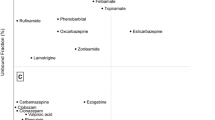Abstract
The choice of which antiepileptic drug (AED) to use in individual patients is challenging, especially in patients with co-morbid renal or hepatic impairment. The individual’s degree of renal or hepatic impairment influences the initial selection of AEDs, and may necessitate changes in existing AED treatment.
Similar content being viewed by others
References
Anderson GD, Hakimian S. Pharmacokinetic of antiepileptic drugs in patients with hepatic or renal impairment. Clin Pharmacokin. 2014;53(1):29–49.
French JA, Gazzola DM. Antiepileptic drug treatment: new drugs and new strategies. Continuum (Minneap Minn). 2013;19(3 Epilepsy):643–55.
Frye RF, Zgheib NK, Matzke GR, et al. Liver disease selectively modulates cytochrome P450-mediated metabolism. Clin Pharmacol Ther. 2006;80(3):235–45.
Brater DC. Drug dosing in patients with impaired renal function. Clin Pharmacol Ther. 2009;86(5):483–9.
Benet LZ, Hoener BA. Changes in plasma protein binding have little clinical relevance. Clin Pharmacol Ther. 2002;71(3):115–21.
Matzke GR, Aronoff GR, Atkinson AJ Jr, et al. Drug dosing consideration in patients with acute and chronic kidney disease—a clinical update from Kidney Disease: Improving Global Outcomes (KDIGO). Kidney Int. 2011;80(11):1122–37.
Cockcroft DW, Gault MH. Prediction of creatinine clearance from serum creatinine. Nephron. 1976;16(1):31–41.
Levey AS, Bosch JP, Lewis JB, et al. A more accurate method to estimate glomerular filtration rate from serum creatinine: a new prediction equation. Modification of Diet in Renal Disease Study Group. Ann Intern Med. 1999;130(6):461–70.
Levey AS, Stevens LA, Schmid CH, et al. A new equation to estimate glomerular filtration rate. Ann Intern Med. 2009;150(9):604–12.
Park EJ, Pai MP, Dong T, et al. The influence of body size descriptors on the estimation of kidney function in normal weight, overweight, obese, and morbidly obese adults. Ann Pharmacother. 2012;46(3):317–28.
Morgan DJ, Smallwood RA. Clinical significance of pharmacokinetic models of hepatic elimination. Clin Pharmacokinet. 1990;18(1):61–76.
Bryant AE, Dreifuss FE. Hepatotoxicity associated with antiepileptic drug therapy. CNS Drugs. 1995;4(2):99–113.
Felbatol® (felbamate): US prescribing information. Somerset: MEDA Pharmaceuticals; 2011.
Depakane (valproic acid): US prescribing information. North Chicago (IL): AbbVie Inc.; 20.
Knights MJ, Finlay E. The effects of sodium valproate on the renal function of children with epilepsy. Pediatr Nephrol. 2014;29(7):1131–8.
Unay B, Akin R, Sarici SU, et al. Evaluation of renal tubular function in children taking anti-epileptic treatment. Nephrology. 2006;11(6):485–8.
Mahmoud AA, Rizk T, El-Bakri NK, et al. Incidence of kidney stones with topiramate treatment in pediatric patients. Epilepsia. 2011;52(10):1890–3.
Disclosure
This article was adapted from Clinical Pharmacokinetics 2014; 53(1):29–49 [1]. The preparation of these articles was not supported by any external funding.
Author information
Authors and Affiliations
Consortia
Rights and permissions
About this article
Cite this article
Adis Medical Writers. Consider potential alterations in drug metabolism and excretion when selecting antiepileptics in patients with renal or hepatic impairment. Drugs Ther Perspect 30, 330–334 (2014). https://doi.org/10.1007/s40267-014-0139-z
Published:
Issue Date:
DOI: https://doi.org/10.1007/s40267-014-0139-z




